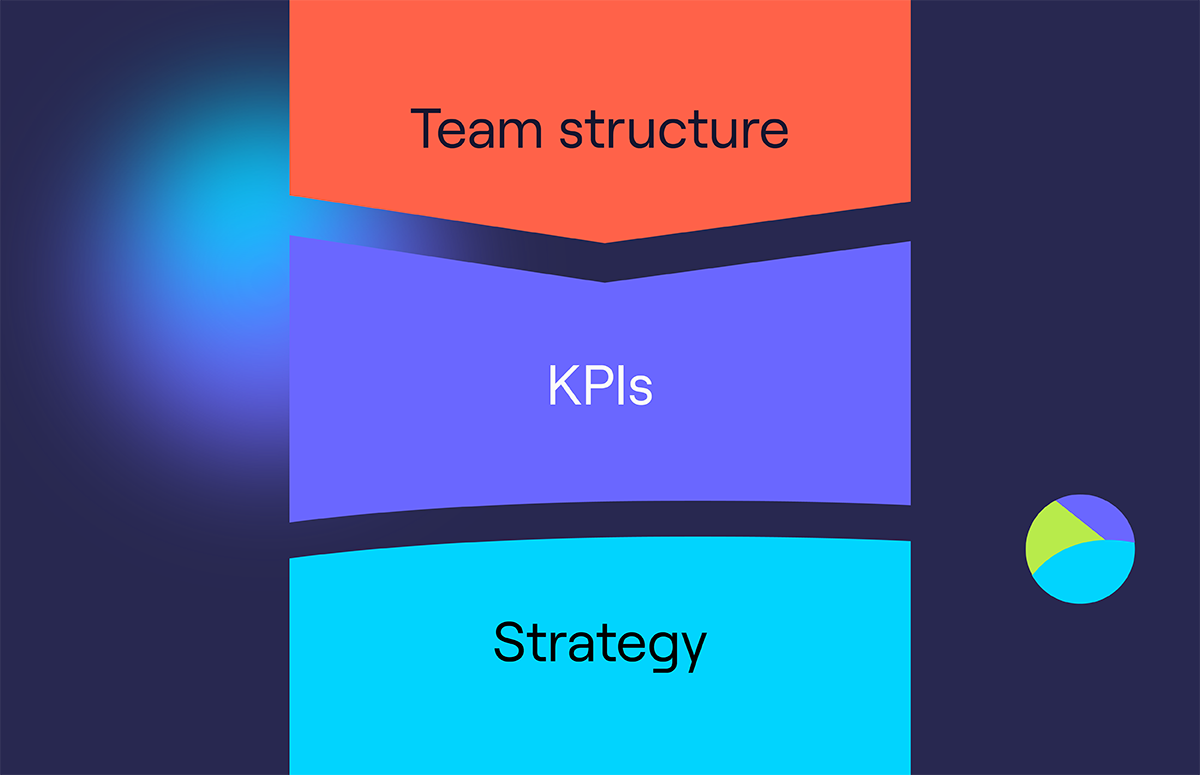How to Build the Perfect Revenue Operations Team Structure
Revenue operations team menu:
Revenue Operations (RevOps) is one of the fastest-growing business departments.
A recent survey found that 63% of small businesses already have a formal RevOps team.
Looking to follow suit and unify your approach to generating revenue?
We’ve got you covered.
Read on to learn everything you need to know about building a RevOps team, from the two most common structures to a step-by-step plan for making your first RevOps hire.
What factors determine your RevOps team structure?
There are many different ways to structure a revenue operations team.
The ideal team structure for your particular B2B company depends on two main factors — your team size and RevOps needs.
These factors also govern how you expand your team — aka which roles you’ll hire first.
Let’s explore these factors and how they affect decisions about team structure. Then, we’ll offer two template structures you can try on for size.
👉 Find out why you need Cognism on your RevOps team; optimise resources and build a better pipeline.
1. The size of your team
Most companies don’t start by building a massive RevOps department.
Most start with a smaller, more agile team designed to tackle a few big challenges holding back their revenue teams.
According to The State of RevOps Report, only 17.1% work in a team of 10 or more.
These smaller teams usually consist of a few RevOps generalists who can handle data analysis, project management, technology, revenue strategy, and process optimisation for their revenue engine.
For example, a RevOps team of four might look like the following:
- VP of Revenue Operations: Oversees the organisation’s revenue streams.
- Head of Marketing Operations (MarOps): Oversees marketing revenue streams.
- Head of Sales Operations (SalesOps): Oversees sales revenue streams.
- Head of Customer Success Operations(CSOps): Oversees customer success revenue streams.
As the business grows, each team lead will likely hire more specialists under them to fill in skill gaps and seize new opportunities to boost revenue efficiency.
Which brings us to the second factor determining the ideal team structure ⬇️
2. Your specific RevOps needs
Like civilisations expand according to their natural resource needs, RevOps teams grow based on their current struggles.
For example:
Suppose you’re currently struggling with CRM management. In that case, you might begin by hiring a CRM administrator to manage your CRM and create standardised processes for entering data across revenue teams.
With the future in mind, you may also hire a Chief Revenue Officer who can provide strategic vision and lead team building.
Since every company has unique RevOps needs, they all have different structures — much like custom-built homes.
RevOps Executive Darren Fay states in an interview that his company, Instructure, has a Business Intelligence (BI) team within the larger RevOps team.
This BI team consists of multiple data insight specialists who can advise the heads of the MarOps, SalesOps, CSOps, and Renewals teams.
What are the common RevOps team structures?
Despite the wide variety of possible RevOps team structures, you can build your team using two standard templates.
1. By revenue department
The most common way to structure a RevOps team is to break the team into three main divisions:
- MarOps.
- SalesOps.
- CSOps.
In this structure, each division is focused on optimising the operations of one revenue department and reports to the RevOps team leader — typically the Chief of Revenue Operations.
Each division consists of several Revenue Operations Managers, each handling a specific function, whether that’s web platform management in MarOps or sales enablement in SalesOps.
Sometimes, companies create a fourth division (they may call it the Operations Team), which consists of specialists who work across the entire RevOps team. Each RevOps division can leverage these consultants when needed.
These specialists ensure alignment between divisions and provide expertise in key operations areas.
For example, Samuel Thimothy’s RevOps structure has an operations division of project managers, data analysts, and technology specialists.
This structure works well if you have operations professionals on your various revenue teams and plan to move them to a new RevOps team.
For example:
The Sales Ops employee who currently sits on the sales team can become the Head of Sales Ops on the RevOps team. The transition is simple — they don’t have to learn so much about marketing or CS operations, just enough to collaborate with the leaders of those divisions.
Of course, when you use this structure, you risk your RevOps team becoming siloed by the revenue department — the very problem you set out to solve with a RevOps function.
To keep this from happening, many RevOps leaders use the following structure ⬇️
2. By RevOps function
Another common way to structure a RevOps team is to break it into divisions by RevOps function.
Here’s an example of this:
|
Data Insights |
Process Optimisation |
Revenue Enablement |
Technology & Systems |
|
Manager of Data Insights |
Manager of Process Optimisation |
Enablement Manager |
Manager of Technology & Systems |
|
Business Intelligence Specialist |
Project Manager |
CS Enablement Specialist |
CRM Administrator |
|
Junior Data Analyst |
SalesOps specialist |
Sales Enablement Specialist |
Marketing Software Admin |
This allows for deep specialisation. Each team is a master at one specific RevOps skillset.
The structure also ensures a holistic approach to RevOps, since each division will work on projects across MarOps, SalesOps, and CSOps. Often, to accomplish company goals, they’ll have to work with the other divisions.
For example:
Setting up a new sales process workflow in your CRM would involve insight into the customer journey from Data Insights, sales process best practices from Process Optimisation, and CRM expertise from the Technology division.
Now that’s playing the revenue game like a team!
What are the common RevOps roles?
Every RevOps team will look different, but here are some common RevOps roles and their chief responsibilities:
VP of Revenue Operations
Leads the overall revenue strategy and optimises the entire revenue engine across sales, marketing, and customer success. Responsible for aligning departments, setting KPIs, and driving revenue growth initiatives.
MarOps Specialist
Manages marketing automation platforms and ensures effective lead generation, routing, and scoring systems. Analyses marketing campaign performance and optimises marketing-to-sales handoff processes.
Sales Ops Specialist
Maintains sales processes, territory planning, and quota management to maximise sales efficiency. Provides analytics and insights to help sales teams improve performance and support revenue forecasting.
CSOps Specialist
Develops and optimises customer success processes to improve customer retention and expansion opportunities. Manages customer health scoring systems and creates scalable customer engagement frameworks.
Enablement Specialist
Creates training programs and resources like competitive battlecards or sales decks to improve performance across sales and CS. Develops playbooks and ensures teams have the right tools and knowledge to succeed.
CRM Admin
Manages the CRM system’s configuration and maintenance while ensuring data quality. Sets up integrations and creates workflows, custom fields, and automation to improve CRM adoption and efficiency.
Deal Desk Admin
Reviews and processes complex sales deals while ensuring compliance with pricing and legal requirements. Streamlines quote-to-cash processes and maintains pricing governance.
Data Analyst
Performs deep analysis of revenue metrics and creates actionable insights for process improvement and go-to-market strategy. Builds dashboards and reports to track key performance indicators across the revenue organisation.
Technology Manager
Oversees the revenue tech stack and ensures all systems are properly integrated and functioning. Makes strategic decisions about technology investments and manages vendor relationships.
Project Manager
Coordinates cross-functional revenue initiatives and implements new processes and tools. Manages timelines, resources, and stakeholder communication for revenue operations projects.
What skills are essential for RevOps team members?
According to the State of Revenue Operations Report, problem-solving is considered the most essential skill in a potential RevOps Manager, followed by data analysis, communication, and collaboration.
Problem-solving and communication are critical for SalesOps, MarOps, and CSOps team leaders; they must devise creative plans to solve issues and mobilise specialists to accomplish them.
While specialist team members like CRM admins or sales enablement specialists require people skills, they also need more specialised expertise.
For example:
A CRM admin must be well-versed in the nuances of your CRM platform, and a data analyst must be up to date on current revenue analysis methodologies and systems.
How do you build a RevOps team from scratch?
To build a RevOps team from nothing, it helps to follow a strategic 4-step process.
1. Audit your revenue engine
Start by identifying key opportunities for optimisation.
Ask the following questions:
- What are the biggest issues compromising revenue generation?
- What initiatives would solve these issues?
- Which skillsets are needed to manage these initiatives?
This assessment will help you determine the key roles you’ll hire for your RevOps team.
It may also help to learn what RevOps departments in your industry are focusing on.
According to a recent RevOps report by HubSpot, here are the biggest priorities for RevOps teams:
2. Secure buy-in from key stakeholders
This often means presenting the findings from your revenue audit to other executives who must approve your team’s creation.
Come prepared with a plan for how your first RevOps projects will improve efficiency.
3. Make your first RevOps hire(s)
This doesn’t have to be a VP of RevOps or CRO.
However, it should be a RevOps Manager with the skills and leadership qualities necessary to build a team while solving your current RevOps problems.
Preferably, they’ll have some familiarity with at least 2-3 of the following RevOps functions: systems and tools, process optimisation, data analysis, enablement, and revenue strategy.
If you have the resources, you may also want to consider hiring more revenue operations professionals and creating a full-scale team.
4. Grow your team based on skill gaps and long-term priorities
Most companies will want to focus on growing their MarOps and Sales Ops functions before CSOps. Why?
Because winning new customers is often the best lever to pull for business growth.
What are the common challenges of building a RevOps team?
When building your RevOps team, you may encounter the following hurdles:
Data quality issues
Inaccurate or outdated data hinders your ability to generate accurate data-driven insights that help your revenue teams succeed.
You can fix this problem with an AI-powered B2B enrichment tool like Cognism. This tool populates CRM records with fresh and compliant data on your contacts and accounts.
Take an interactive tour to see how Cognism’s data enrichment works 👇
Finding RevOps talent
Those first hires can be tough if you’re looking for a jack-of-all-trades who can handle data insights, manage the tech stack, and optimise revenue processes.
But they’re out there. To speed up your search, tap into your network and sell the idea of being the first hire with a chance to build a new team.
Resistance to change
Some employees might find creating a RevOps team uncomfortable, especially the operations staff, who may feel they’re being uprooted from their groove.
To make the transition as smooth as possible, institute a change management strategy that ensures your new processes are embraced, not resisted.
What are some tips for hiring RevOps team members?
Below are some best practices for finding top RevOps talent ⬇️
Determine if the role is technical or strategic
When hiring RevOps business leaders, find candidates with a strategic, team-building history. These employees will serve as long-term strategic advisors and the foundation of your RevOps department.
For specialist roles that mainly involve accomplishing tasks, you can focus on finding team members with the right technical skills and know-how.
Focus first on hiring generalists (or fast learners)
When you’re first building out your RevOps team and it’s still small, you’ll want to find team members who can play various roles.
They don’t need to be RevOps masters, but they should have a history of quickly learning new skills and technologies.
This way, when a new revenue initiative comes up, you don’t have to hire an entirely new employee. A resourceful member of your current team can figure it out.
Look for cross-departmental collaborators
RevOps employees need to be able to work across departments.
And not just across sales, marketing, and customer success but also IT, finance, legal, and the entire organisation.
This is how RevOps creates a culture of teamwork, information sharing, and cross-departmental strategy.
Therefore, look for RevOps professionals with experience presenting to and working with stakeholders in other departments.
What tools do revenue operations teams need?
Check out the five types of tools most RevOps teams can’t live without:
- Sales intelligence software like Cognism provides your team with accurate, compliant B2B data that powers targeted sales outreach and email marketing. Enrich your CRM with fresh data so every team operates from the same information.
- A Customer Relationship Management (CRM) platform like Salesforce or HubSpot is the single source of truth for all customer data, interactions, and revenue tracking.
- Revenue Operations and Intelligence (RO&I) software like Gong or Clari provides AI-powered insights into deal health and revenue team performance.
- A Configure, Price, Quote (CPQ) tool like Salesforce CPQ automates pricing rules and proposal generation, streamlining the quoting process.
- Contract Lifecycle Management (CLM) software like DocuSign helps teams create contracts, track signatures, and automate workflows to reduce bottlenecks.
Depending on your teams’ priorities, you might also use automated lead routing tools, digital deal room software, and business intelligent solutions.
FAQs
What is the difference between RevOps and traditional operations teams?
Traditional operations roles existed within different departments. The MarOps Specialist was on the marketing team, the SalesOps Specialist was on the sales team, and so on.
RevOps, on the other hand, brings those operations roles onto one team known as revenue operations.
With all the operations employees working closely together, they avoid information siloing and can more easily find data-driven ways to optimise growth.
Read this blog to learn more about the differences between RevOps vs. sales ops.
How does a RevOps team drive alignment across departments?
RevOps creates a single source of truth for data and standardises processes across marketing, sales, and customer success teams. In this way, it drives alignment.
Further, it establishes shared metrics and KPIs so all departments work toward the same revenue goals.
This avoids misalignments, like marketing celebrating 1,000 MQLs, while sales is annoyed because the MQLs were small businesses when they would’ve preferred fewer, more lucrative enterprises.
RevOps also facilitates regular communication and creates shared incentives to ensure everyone moves in the same direction.
How can Cognism help your RevOps team?
Create a data-backed RevOps team with Cognism’s compliant B2B data, including phone-verified mobile numbers, notified B2B emails, and intent data.
Enrich your CRM records, plan territories, and calculate your TAM with Sales Companion designed for RevOps teams.
To see how Cognism can boost your revenue efficiency, book a free demo today ⬇️

/Lead%20routing%20tools/lead-routing-tools-resource-card.webp)

